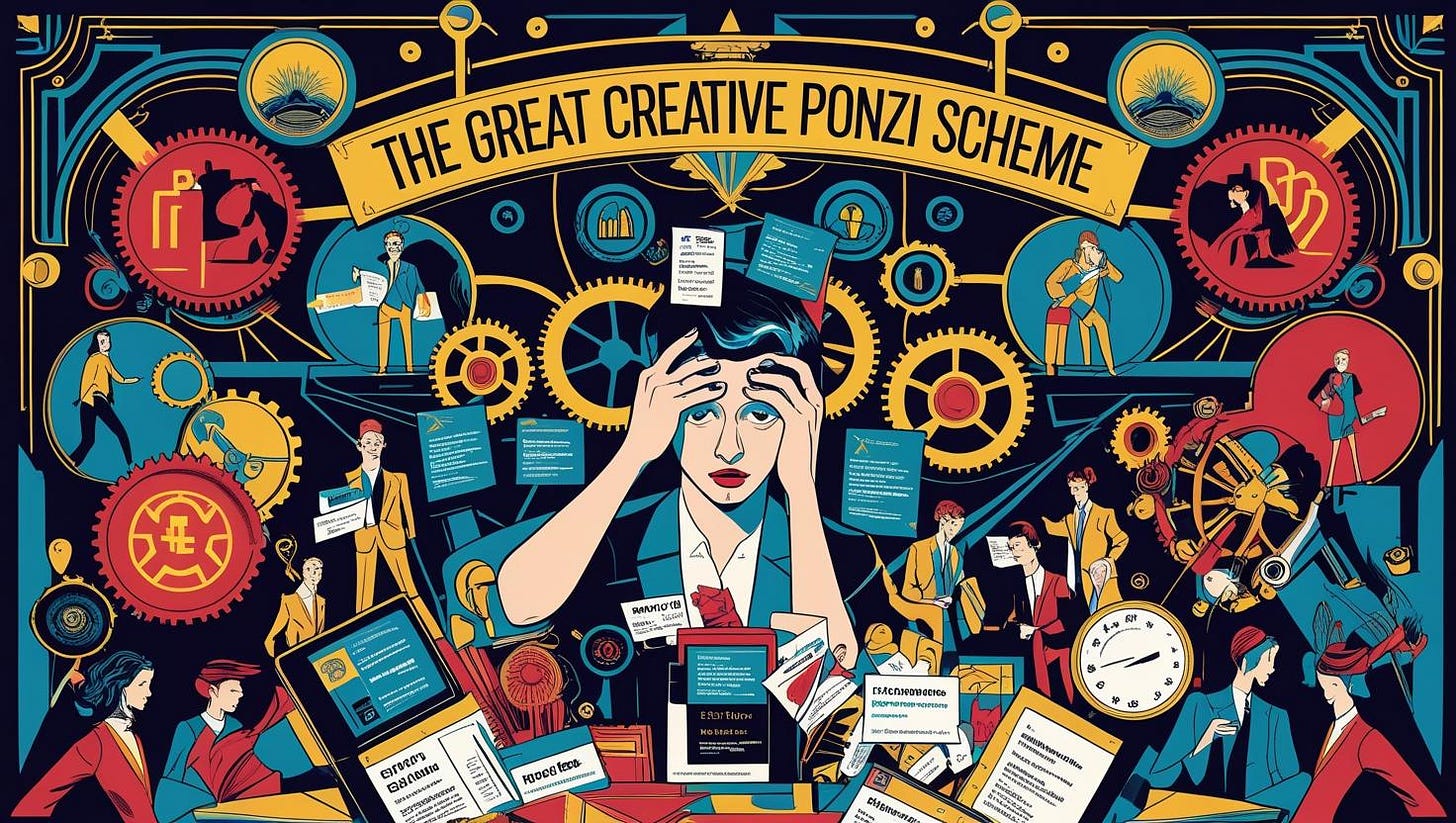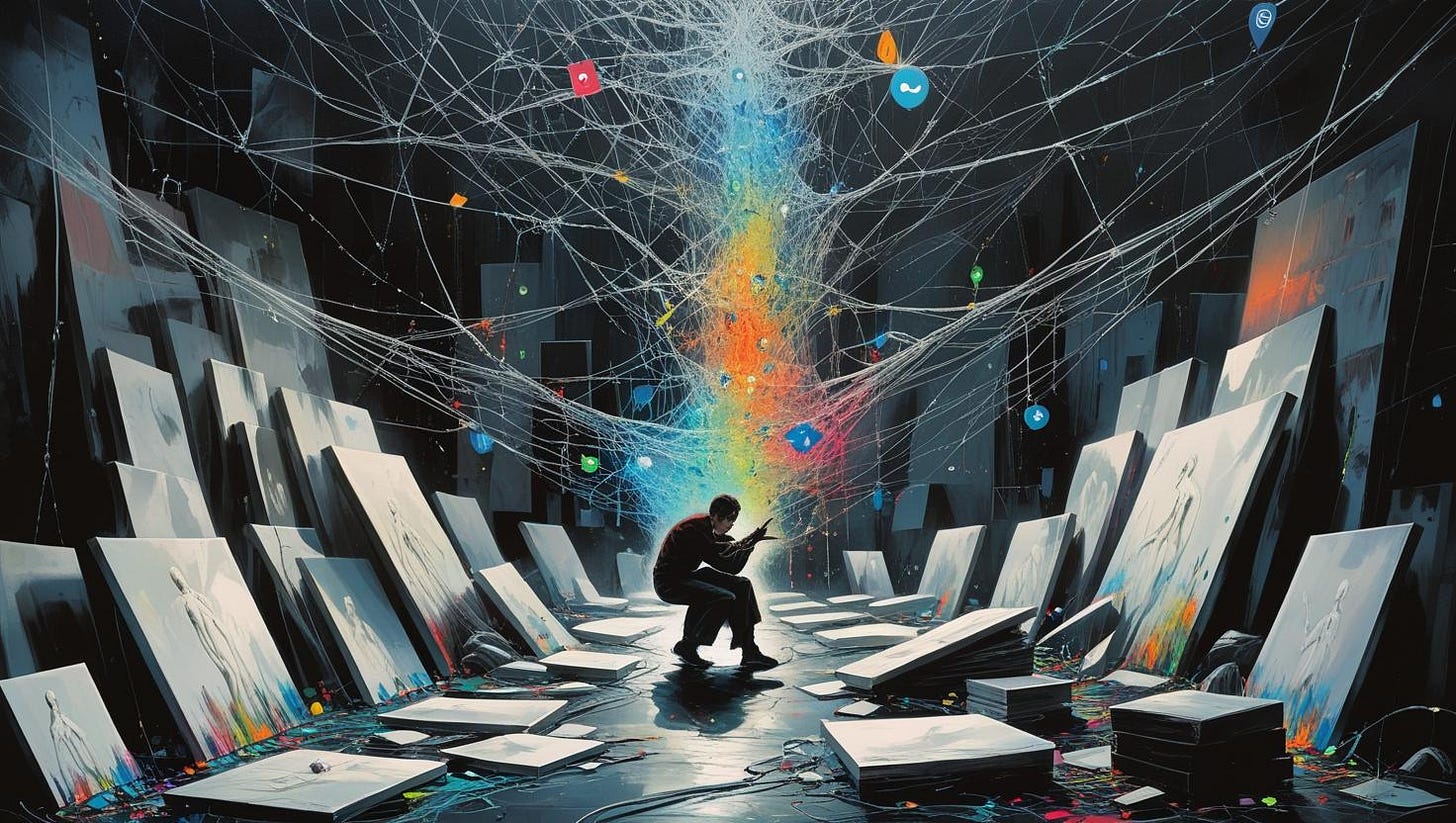Welcome to Open Sources from alchima_
The go-to resource and guide for leading artists and pioneering creatives who are currently busy nurturing and cultivating their next phase of work but find themselves increasingly concerned about the effects of Creative Compression on their focus, work, craft and practice.
Typical Signs of Creative Compression:
Oversaturated by the constant demands and digital noise of content production
Overwhelmed by the ‘always on’ filtering of algorithms, feeds, platforms and AI
Overstretched and disconnected from your intentional attention in your practice
Overcome by a loss of motivation around commencing your next phase of work
alchima_ is a new type of lab that leverages alchemic creativity in vibrant new ways, in order to rapidly navigate new paths into our most pressing cultural challenges and complex contemporary conversations.
The Great Creative Ponzi Scheme.
Part 2 | The Audience Trap
In Part 1 of The Great Creative Ponzi Scheme, we examined how artists have become their own marketing departments. Today, we dive deeper into the paradox at the heart of the modern creative economy: the very audience-building activities that promise career advancement often undermine the artistic development they're meant to support.
Here's the central contradiction of The Great Creative Ponzi Scheme: the activities required to build an audience are often antithetical to the activities required to develop as an artist.
Yet artists are told these two goals are not just compatible but synonymous.
Building an audience demands consistency, accessibility and engagement. It rewards content that can be quickly consumed and easily shared. It favors the familiar over the challenging, the immediately comprehensible over the mysteriously complex.
Artistic development, meanwhile, thrives on inconsistency, experimentation and periods of deep, unobserved work. It requires the freedom to fail, to pursue ideas that may lead nowhere, to spend months or years on problems that have no guaranteed payoff.
The Content Mill
Social media platforms have transformed artists into content creators, but these roles require fundamentally different skill sets and mindsets. A content creator optimises for engagement metrics, posting schedules, and audience retention. An artist calibrates for truth, beauty, meaning via a refined aesthetic philosophy that often informs and drives their work.
The Persona Problem
Building an audience on social platforms often means engaging with the most surface-level aspects of artistic practice. Behind the scenes content tends to focus on tools, techniques and process, rather than the deeper intellectual and emotional work that drives meaningful art.
This creates a strange dynamic where artists become known for their artistic persona rather than their actual art. They develop audiences who are interested in them as characters (or worst - as caricatures) in the creative lifestyle narrative, but who may have limited engagement with the work itself.
Where say musicians with hundreds of thousands of TikTok followers can struggle to sell a hundred concert tickets. Visual artists with massive Instagram followings whose gallery shows draw sparse crowds. Writers whose newsletters have thousands of subscribers but whose books sell in the dozens.
The audience exists but it's an audience for the artist-as-content-creator, not the artist-as-artist.
The Time Suck
Perhaps most damaging is the simple mathematics of attention:
Every hour spent crafting the perfect Instagram caption is an hour not spent writing.
Every morning devoted to responding to comments is a morning not spent in the studio.
Every evening analysing engagement metrics is an evening not spent reading, thinking, or simply living the kind of rich inner life that feeds great art.
The audience-building imperative doesn't just compete with creative work for time – it competes for the artist's most precious resource: their time and mental space to hone and develop their craft.
The part of consciousness that should be occupied with artistic problems becomes preoccupied with audience development problems.
The Validation Trap
Social media metrics create an immediate but hollow form of validation. Likes and comments provide quick dopamine hits that can become addictive, especially for artists who otherwise work in solitude with little immediate feedback on their work.
This instant gratification can undermine the artist's tolerance for the slow, uncertain work of artistic development.
Why spend six months on a piece that might fail when you can get hundreds of likes on a studio selfie posted in thirty seconds?
The external validation loop of social media can atrophy an artist's internal compass – their ability to judge their own work independent of audience reaction.
The Career Mirage
The cruelest aspect of the audience trap is that it often doesn't deliver the career advancement it promises. Industry professionals may pay attention to follower counts, but they still make decisions based on the quality and market viability of the work itself.
An artist with a large social media following but underdeveloped artistic skills is like a startup with great marketing but a mediocre product.
The attention is real, but it's not sustainable without substance to back it up.
Meanwhile, artists who focus primarily on their craft often find that industry attention follows naturally.
Great work has a way of finding its audience, even if that process takes longer and looks less measurable on a dashboard.
Final instalment of the Great Creative Ponzi Scheme to come in the next post.
In a few short sessions of working through the terms and framework alchima has developed, I went from feeling burnt-out and stuck to energised and full of an irrepressible urge to make stuff. Dan Am’s concepts helped me untangle the tangle and extract the golden threads of joy from deep within the mess. Together using this new magic language, we found ways for me to create space for myself away from my business; ways of working to satisfy my current need for physical formats; and ways of working that will enable me to process my lost ability to knit (previously essential to my work) and my late diagnosis of neurodivergence.
Felix (Felicity) Ford | www.knitsonik.com
I've worked with many creative minds over the years, but Dan stands out. His polymathic thinking, fearless exploration of new ideas, and unfiltered encouragement create a rare energy. Beyond his creativity, Dan is a steady, approachable presence — the kind of ally we all need in today's world.
Ryan Board | www.board.cc
As a modern day philosopher and practitioner of systemic constellations, I am fortunate to have to navigate paths through many original and enquiring minds - both past and present. However, there is something about Dan’s innate ability to consistently decode and decipher concepts and language into emergent and vibrant new forms that always stands out. It sometimes seems like he is channeling disruptive ideas in real time out of the ether like jazz or street poetry!
Robert Rowland Smith | www.robertrowlandsmith.com




